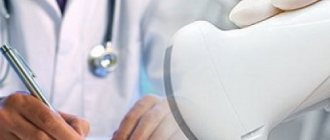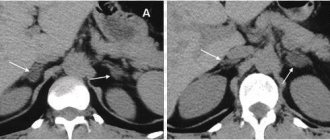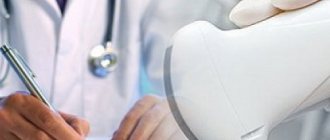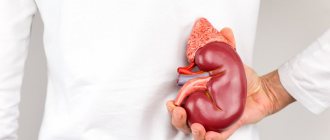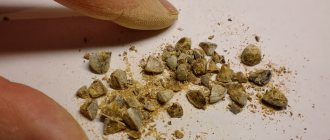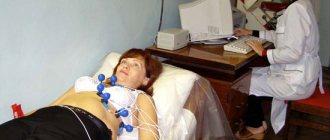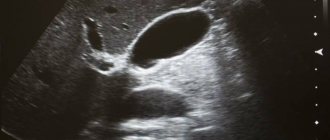Ultrasound examination is one of the most reliable diagnostic methods.
The technology allows an ultrasound doctor to assess the condition of organs and tissues, identify deviations from the norm, clarify the localization of an inflammatory or other pathological process, the location and size of a tumor, and diagnose various diseases. The accuracy of ultrasound results is influenced by several factors, including proper preparation for the examination. If the recommendations are not followed, the image obtained using an ultrasound machine may be distorted.
It is important to know how to properly prepare for an ultrasound of the bladder and kidneys.
What does an ultrasound of the kidneys and bladder show?
During the procedure, the doctor can diagnose:
- injuries and malformations of organs;
- acute and chronic diseases of the kidneys and bladder;
- stones, various neoplasms in the urinary system.
Using an ultrasound, a specialist evaluates the size, shape, location, mobility of organs, identifies abnormalities in tissue structure, and the presence of space-occupying formations. The following reminder for preparing for an ultrasound of the kidneys and bladder will help you obtain reliable diagnostic results.
Is it possible to eat before an ultrasound of the kidneys and bladder?
The list of foods that can be eaten before a kidney ultrasound for 2 days is limited to simple, light food that does not form gases in the intestines. You cannot eat directly on the day of the test, so it is usually prescribed in the morning. If you are scheduled for an examination during the day or evening, your last meal should be no later than 6-8 hours before the ultrasound.
You can have breakfast before a separate examination of the bladder, but not before an ultrasound of the kidneys or a comprehensive examination of the urinary system.
Is it allowed to eat and drink water before the test?
There is a misconception among people that prior to an ultrasound scan of the kidneys, no preliminary preparation or diet is required, since the lumbar region is scanned, and the gastrointestinal tract organs are not affected and do not affect the result in any way. But increased gas formation in the intestines disrupts the movement of ultrasound and the reliability of the method decreases.

Before an ultrasound scan of the kidneys, it is necessary to change your usual diet and switch to a light diet. This is necessary to better carry out the procedure and obtain accurate data. Ultrasound waves do not pass through gases in the intestines. Changing the diet is aimed at preventing the formation of gases or eliminating them.
It is allowed to eat before the ultrasound, but with significant restrictions. You need to remove all heavy foods, seasonings and even some fresh vegetables from your diet. It is also necessary to review the water balance.
Liquids
Before the ultrasound, you are allowed to drink boiled water, green or lightly brewed black tea without sugar. Juices without pulp or diluted fruit drinks are also allowed. Drinks must be free of preservatives and dyes.
Herbal and vitamin preparations will help diversify your drinking during preparation. For preparation you can take:
- chamomile;
- mint and lemon balm;
- linden;
- sage;
- cherry or raspberry leaves.
Before the study, sweet soda and kvass are strictly prohibited. These drinks contain a high content of yeast, which causes gas formation. Also, 3 days before the ultrasound, abstinence from alcohol is required.

On the day of the procedure, you will need to increase the volume of fluid. Within an hour before the ultrasound, you need to drink from 500 ml to 1 liter of permitted liquid. In the morning, you can drink unsweetened herbal tea; closer to the procedure, it is better to drink only clean water without carbon.
Important! Before diagnosis, the bladder should be full, as this will improve the passage of ultrasound and increase information content. When emptying the bladder, the meaning of pre-drinking is completely lost.
How much fluid should you drink to fill your bladder? Volumes depend on the age and weight of the patient. An adult needs from 500 ml to 1.5 liters. Children's fluid requirements vary further:
- from 1 to 2 years – half a glass of clean water;
- 2-7 years – a full glass of water;
- 7-11 years – one and a half glasses;
- 11-16 years – 400-500 ml of liquid.
The main causes of dark urine in women, and what does it mean?
Another formula for determining the fluid level before an ultrasound of the kidneys is 5-10 ml of water per 1 kg of weight.
Food
Doctors advise refraining from eating 8 hours before the procedure. It is mandatory to follow this rule during a comprehensive examination (if, in addition to the kidneys, ultrasound of other abdominal organs is indicated). Before the study, you need to follow a diet for 3-4 days, and have a light dinner the day before the procedure. Avoid breakfast.

We list the main aspects of proper nutrition before a kidney ultrasound:
- Elimination of all spices and seasoned foods from the diet.
- Prohibition on fatty, fried, smoked foods.
- Do not eat cabbage and legumes.
- Complete refusal of sweets and baked goods.
- Temporary abstinence from milk and dairy products.
What you can and cannot do and eat before an ultrasound, how to prepare for the examination so that the results are as reliable and informative as possible for the doctor, you will learn from this video:
Proper diet
The purpose of a therapeutic diet is to unload the stomach and intestines and eliminate increased gas formation. The duration of the diet can vary from 2 to 5 days, but the optimal duration is 3 days before the kidney ultrasound. During this period, you need to eat fractionally, at time intervals of 3-4 hours.
Before diagnosis, frying food is prohibited. Recommended boiling, stewing, steaming.
What products are prohibited? We summarize, expand and explain the list.
| Product | Why not? |
| Legumes (peanuts, soybeans, beans, lentils, chickpeas). | The high content of difficult-to-digest polysaccharides in the composition contributes to increased gas formation. |
| Confectionery and rye bread. | The reason is identical - gas formation. |
| Dairy products with lactose. | There are few enzymes in the adult body that can break down milk sugar. Lactose, entering the intestines, begins to ferment vigorously, causing flatulence. |
| Some spices. Cumin, all types of pepper, curry and others. | Irritation of the gastrointestinal mucosa. |
| Fresh vegetables without heat treatment. Figs | Increased content of polysaccharides. |
Also prohibited are fatty meats, canned food, pickles, marinades, ketchup and mayonnaise, potato dishes, dried fruits, seeds and nuts.
The list of permitted dishes is extensive, so it will not be difficult for a person to choose the optimal and varied menu for himself. The pre-preparation diet includes the following foods:
- Porridge cooked in water. You can add a little vegetable, olive, butter. Suitable cereals include buckwheat, oatmeal, pearl barley and rice.

- Hard cheeses with low fat content. But no more than 50 g per day.

- Poultry (boil or steam). Rabbit or beef are also allowed.

- Low-fat fish (contains no more than 4% fat). Cod, flounder, pollock, hake, blue whiting, halibut.

- Hard-boiled eggs. But no more than 1 per day. Scrambled eggs and omelettes should be avoided.
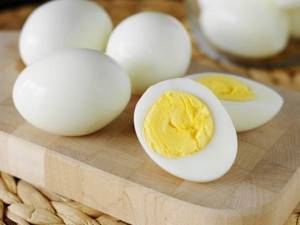
- Light, not rich soup, chicken broth.

- White bread. It is recommended to eat slightly dried.
Medication component
Appointed and supervised by a specialist. If the gastrointestinal tract is stable, then before the ultrasound you need to drink carminatives or sorbents for 2-3 days. These are white or regular activated carbon, Espumisan, Smecta, Sorbex.
If you have digestive problems (constipation or bloating), you need to drink sorbents, and an enema is indicated 12 hours before the ultrasound. You can use a regular enema or use a special Mirolax enema. An alternative to an enema is mild laxatives. These are Phytolysin, Guttalax and others.
In some pathologies, on the contrary, taking a diuretic before an ultrasound is indicated. Among them:
- various dysuric disorders;
- increased tendency to edema;
- chronic kidney or heart disease.
20-30 minutes before ultrasound scanning you need to drink Furosemide, Hypothiazide or analogues. The goal is to stimulate urine production so that an ultrasound of the kidneys is performed on a full bladder.
To normalize the functioning of the gastrointestinal tract, the use of enzymes to improve digestion is also indicated. Festal, Pancreatin, Mezim should be taken 1 tablet before meals.
Attention! Proper preparation for the examination will give the doctor the opportunity to accurately and easily identify possible diseases of the kidneys and other organs of the genitourinary system.
Can I have breakfast before the procedure?
If a patient is indicated for a combined ultrasound of the kidneys and an ultrasound of the abdominal cavity, be sure to fast for 8-12 hours before the procedure. For preschool children it is 5 hours, for infants it is 1 hour. In this case, the evening meal before the procedure should be easily digestible and not plentiful.
What to eat before a combined ultrasound of the kidneys and other abdominal organs?
- An excellent main course is any approved water-based porridge.
- A suitable side dish is boiled or steamed fish (hake, pollock).
If the patient is only shown an ultrasound of the kidneys and this procedure will be performed in the afternoon, then a very light breakfast is allowed. For example, oatmeal on water without a side dish. You need to eat no later than 9-10 am. If the examination is carried out in the morning or before lunch, breakfast should be completely abandoned.
For a more accurate study, it is recommended to drink Espumisan 2 hours before the ultrasound. The drug will reduce the content of gases in the intestines, which disrupt visualization and reduce information content. After an ultrasound, it is forbidden to overeat, since after a diet, rich food provokes dyspepsia and constipation.
Experts advise performing an ultrasound of the kidneys in the morning. But in any situation, at least 6-8 hours (for an adult) should pass before examination and eating. 3 days before the procedure, a therapeutic diet and taking enzymes are indicated to normalize the functioning of the gastrointestinal tract. On the eve of the examination, you should definitely avoid any products that increase gas formation.
What not to eat before an ultrasound of the kidneys and bladder
The diet before ultrasound of the kidneys requires excluding from the diet:
- Rye bread;
- fresh fruits, cabbage and other green leafy vegetables;
- alcohol and carbonated drinks;
- products with artificial sweeteners;
- and so on, which can cause the release of large amounts of gas in the intestines.
People with sensitive digestion are advised to avoid foods high in carbohydrates, fried and fatty foods: they can also cause increased gas formation.
If there is a volumetric accumulation of gases, the ultrasonic wave from the sensor will not be able to reach the required depth, which will distort the examination results. How much water to drink before an ultrasound of the kidneys and bladder
Ultrasound of the bladder is performed only if it is full. An hour before the organ examination, you need to drink 1–1.5 liters of water or any other liquid. The same rule applies to complex studies of the urinary system. You can urinate only after the procedure is completed.
Is it possible to drink water before a kidney ultrasound? If during the examination the ultrasound doctor looks only at the kidneys, there is no need to fill the bladder. Immediately before the examination, it is advisable to limit yourself to 100 ml of clean water.
You can drink tea and coffee before a kidney ultrasound
Tea and coffee are considered food, and the study is carried out on an empty stomach. Drinking these or any drinks on the day of the ultrasound is not allowed.
Carrying out the procedure
In our medical center, the ultrasound procedure is performed in a specially equipped room. First, you need to undress to the waist or expose the abdomen and lower back to provide the doctor with access to the area being examined. After this, the patient takes a lying position on a medical couch. An acoustic gel is applied to the area under study, which ensures the closest possible contact of the transducer with the skin, increases ultrasound absorption, and increases the ability of the transducer to slide. During the examination, the doctor can move the sensor over the skin to better visualize a particular organ. The doctor may ask the patient to change his body position: stand up, turn sideways, or lie on his stomach. After the procedure is completed, the remaining gel is removed with a sanitary napkin.
The sonologist enters the results of the study into a protocol,, if necessary, prints out a two-dimensional image of the organ, deciphers the study data, and draws up a conclusion. All stages of the examination take no more than half an hour.
Ultrasound of the bladder in women: how to prepare
General recommendations on how to properly prepare for an ultrasound of a woman’s kidneys are presented above. It is also advisable to take into account the menstrual cycle when choosing the date of the study. When asked whether it is possible to do an ultrasound of the kidneys during menstruation, most doctors answer negatively. It is better to wait until the end of the critical days, since blood clots can distort the ultrasound result.
Is it possible to do an ultrasound of the kidneys during pregnancy?
Ultrasound diagnostics is absolutely safe for the fetus and the body of the expectant mother. Ultrasound is allowed at all stages of pregnancy.
When is an ultrasound scan of the adrenal glands prescribed?
An ultrasound may be prescribed if adrenal disease is suspected. Symptoms of such diseases are:
- muscle weakness;
- weight change (loss or, conversely, excess weight gain);
- chronic hypertension (high blood pressure) or hypotension (low blood pressure);
- sexual dysfunction, decreased potency, menstrual irregularities, excess hair growth.
Ultrasound of the adrenal glands can reveal:
- cysts;
- tumors;
- hematomas;
- foci of inflammation;
- increase in the size of the adrenal glands (hyperplasia).
Preparing a child for an ultrasound of the kidneys and bladder
Many mothers do not understand how to prepare their child for an ultrasound of the kidneys and bladder if he cannot drink a liter of water. This volume is usually not needed.
The amount of fluid required to fill a child's bladder is calculated using the formula 5–10 ml per 1 kg of weight. That is, for an average 6-year-old child who weighs 20 kg, only 200 ml of water is enough. Immediately before the procedure, the child should feel the urge to urinate.
An infant can be fed 2 hours before the examination, after which only water can be given. It is important that the baby is calm during the procedure, so it is worth taking a pacifier or pacifier to the ultrasound room.

Return to list
Decoding the result
Immediately after an ultrasound scan of the kidneys, a decoding of the norm in adults or children is provided to the patient. Usually this is a research protocol and several printed photographs. The protocol describes in detail the structure, shape, size and location of each kidney. The presence or presence of any inclusions or formations is also indicated. Based on the data obtained, the attending physician makes a diagnosis or prescribes additional examinations.
A significant number of kidney diseases are associated with changes in their size. Kidney sizes differ between children and adults.
Normal adult kidney size on ultrasound
First, we will describe normal kidney parameters for adults.
Kidney weight – 120-200 grams, length – 100-120 mm, width – 40-60 mm, thickness – 45-55 mm, thickness of the tissue enveloping the kidney (parenchyma) – no more than 23 mm. With age, the parenchyma becomes thinner and by old age it can reach 11 mm.
Normal kidney sizes in children on ultrasound
The size of the kidneys in children depends on age and height. If, for example, we take a child with a height of 50 to 80 cm, then only the length and width of the kidneys will be measured. As a rule, the sizes of the left and right kidneys differ. So, the width of the left kidney will normally be 2.2-2.5 cm, and the length - 4.8-6.2 cm. The width of the right kidney is 2.2-2.4 cm, length - 4.5-5, 9 cm
It must be borne in mind that in each case, the normal sizes for the child’s kidneys are determined individually, based on his physiological data.

